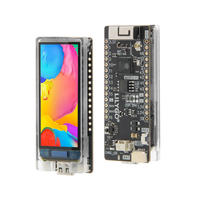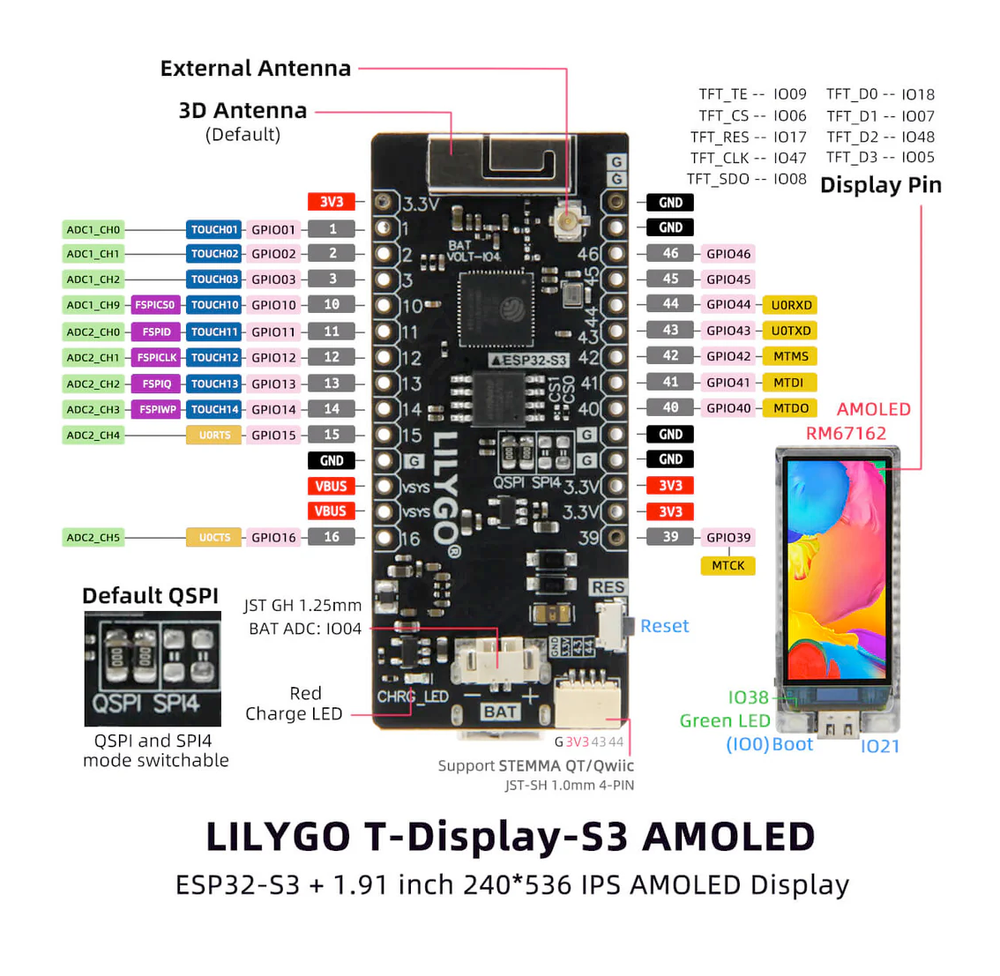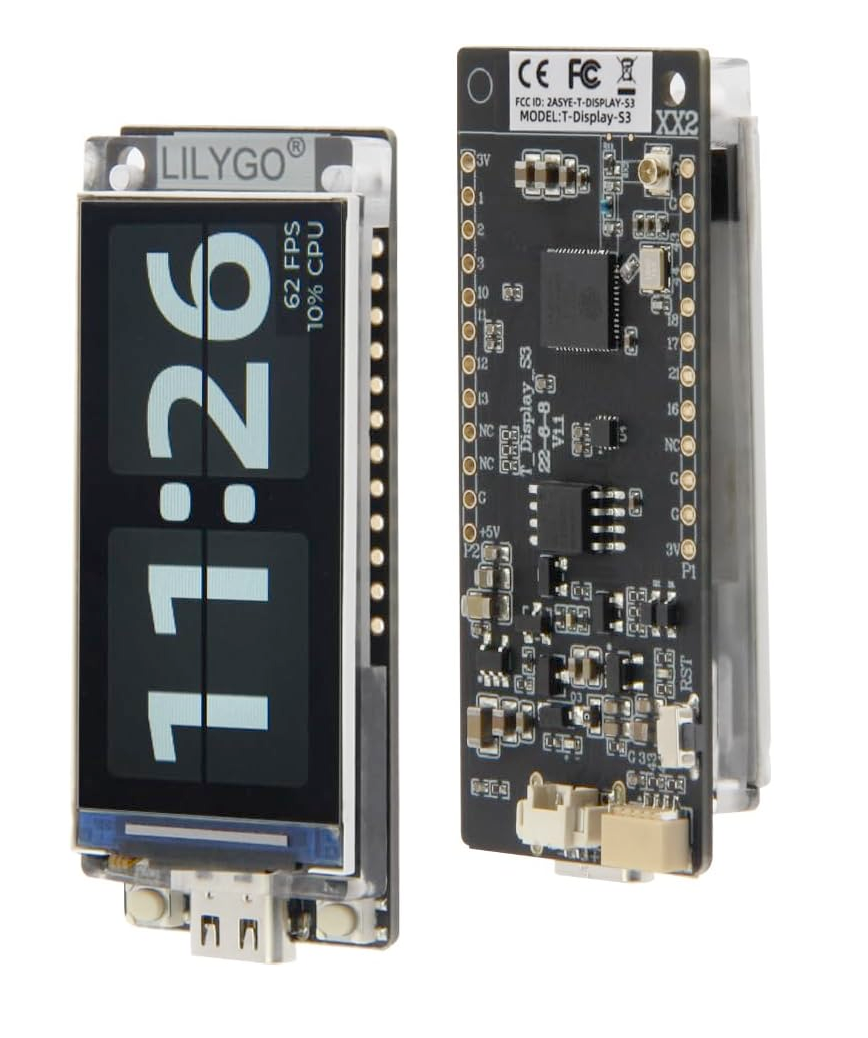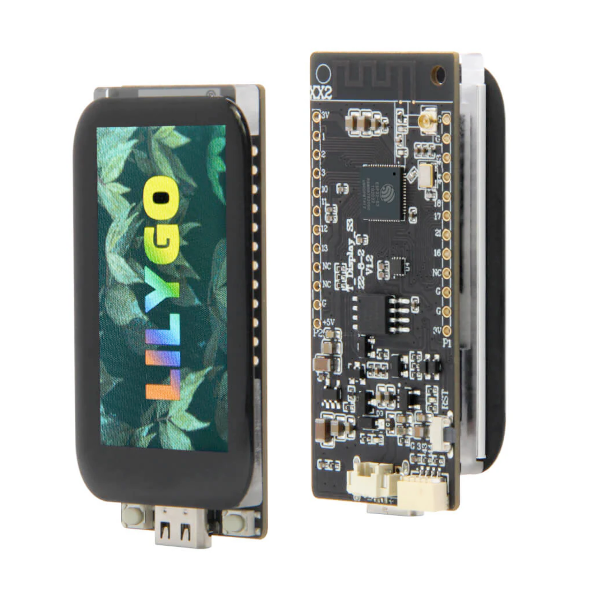LilyGo T-Display-S3 AMOLED Development Board
Code name: LILYGO_T_DISPLAY_S3
LilyGo T-Display-S3 AMOLED development board is based on esp32s3 microcontroller and uses xtensa architecture. This board has a maximum CPU frequency of 240 MHz and a flash size of 16MB.
About LilyGo T-Display-S3 AMOLED
🚀 The LilyGo T-Display-S3 AMOLED is a cutting-edge development board featuring an ESP32-S3 chip with integrated WiFi and Bluetooth 5 capabilities. It boasts a 1.91-inch AMOLED display with a resolution of 536x240 pixels, driven by an RM67162 controller, offering vibrant visuals for embedded applications. ⚡
📡 With support for WiFi 802.11 b/g/n and Bluetooth 5 (LE), it ensures seamless wireless connectivity for IoT projects. The board is equipped with 8MB PSRAM and 16MB Flash memory, providing ample storage and performance.
💾 Designed with multiple GPIOs, PWM, ADC, I2C, and SPI support, it is suitable for various applications, including sensor interfacing, graphical user interfaces, and wireless communication.
Where to Buy LilyGo T-Display-S3 AMOLED


Prices are subject to change. We earn from qualifying purchases as an Amazon Associate.
LilyGo T-Display-S3 AMOLED Technical Specifications
🖥️ Display
🛰️ Connectivity
🧠 Microcontroller
✨ Features
- 48 digital IO pins
- 46 external interrupt pins
- 20 analog input pins
- 27 PWM pins
LilyGo T-Display-S3 AMOLED Pinout
The LilyGo T-Display-S3 AMOLED pinout offers a variety of digital and analog pins, along with a dedicated display interface. Key pins include:
5V and 3.3V power rails for stable operation.
SDA and SCL for I2C, MISO, MOSI, SCK, and SS for SPI communication.
Additionally, dedicated LCD pins ensure efficient display control.
✅ Safe Pins to Use
For general GPIO usage, these are the safest and most flexible choices:
Why Are These Pins Safe?
- Not involved in bootstrapping → No impact on device boot mode or system startup
- Not linked to flash memory or PSRAM → Won't interfere with storage or memory access
- Not dedicated to USB or JTAG → Free for general use without affecting debugging
- No special hardware connections → Freely assignable without internal conflicts
⚠️ Pins to Avoid or Use with Caution
Some pins are reserved for critical functions like bootstrapping, JTAG debugging, USB communication, and flash memory operations. Misusing these pins may lead to boot failures, programming issues, USB conflicts, or disruptions in flash storage.
Critical Pin Categories:
- 🛠️ Strapping Pins: Control boot behavior and flash voltage selection
- 🔗 JTAG Debugging Pins: Required for low-level debugging
- 🔌 USB Communication Pins: Used for USB Serial/JTAG communication
- ⚡ Flash Memory & SPI Pins: Connected to SPI flash memory and PSRAM
- 📡 UART Serial Communication Pins: Used for debugging and firmware uploads
| PIN | Label | Reason | Function |
|---|---|---|---|
| IO0 | GPIO0 | Must be pulled high (default) or low (to enter UART download mode) at reset. Using it for other functions can interfere with boot mode configuration. | 🛠️ Strapping |
| IO3 | GPIO3 | Sampled at reset to select JTAG interface (USB Serial/JTAG controller vs. external pins). Improper use can disable external JTAG or alter debug interface. | 🛠️ Strapping |
| IO9 | FSPIHD | Connected to external flash (data/hold signal) on most modules. Not recommended for use as GPIO, since it must remain dedicated to flash communication. | ⚡ Flash |
| IO10 | FSPICS0 | Used to select the external flash chip. It is required for flash access and cannot be repurposed without losing flash connectivity | ⚡ Flash |
| IO11 | FSPID | Used as a data line for flash (and in-package PSRAM). It should not be used as GPIO when the flash/PSRAM is in use. | ⚡ Flash |
LilyGo T-Display-S3 AMOLED Pin Mappings
This development board provides 48 digital IO pins, out of which 46 can be used as external interrupt pins , 20 as analog input pins and 27 pins have Pulse-Width Modulation (PWM) .
| Pin | Function | ESP Pin | Input/Output | Description |
|---|---|---|---|---|
| 1 | 3V3 | 3.3V | POWER OUTPUT | 3.3V power output |
| 2 | GND | GND | POWER GROUND | Ground connection |
| 3 | 5V | 5V | POWER INPUT | 5V power input for the board |
| 4 | IO0 | A0 | BIDIRECTIONAL | GPIO, ADC pin, Touch, PWM |
| 5 | IO1 | A1 | BIDIRECTIONAL | GPIO, ADC pin, Touch, PWM |
| 6 | IO2 | A2 | BIDIRECTIONAL | GPIO, ADC pin, Touch, PWM |
| 7 | IO3 | A3 | BIDIRECTIONAL | GPIO, ADC pin, Touch, PWM |
| 8 | IO4 | BAT_VOLT | INPUT | GPIO, Battery Voltage Sense, PWM |
| 9 | IO5 | LCD_RES | OUTPUT | GPIO, LCD Reset, PWM |
| 10 | IO6 | LCD_CS | OUTPUT | GPIO, LCD Chip Select, PWM |
| 11 | IO7 | LCD_DC | OUTPUT | GPIO, LCD Data/Command, PWM |
| 12 | IO8 | LCD_WR | OUTPUT | GPIO, LCD Write, PWM |
| 13 | IO9 | LCD_RD | OUTPUT | GPIO, LCD Read, PWM |
| 14 | IO10 | SS | BIDIRECTIONAL | GPIO, SPI Slave Select, ADC pin, Touch, PWM |
| 15 | IO11 | MOSI | BIDIRECTIONAL | GPIO, SPI Master Out Slave In, ADC pin, Touch, PWM |
| 16 | IO12 | SCK | BIDIRECTIONAL | GPIO, SPI Clock, ADC pin, Touch, PWM |
| 17 | IO13 | MISO | BIDIRECTIONAL | GPIO, SPI Master In Slave Out, ADC pin, Touch, PWM |
| 18 | IO14 | BUTTON_2 | INPUT | GPIO, User Button, PWM |
| 19 | IO15 | LCD_POWER_ON | OUTPUT | GPIO, LCD Power Enable, PWM |
| 20 | IO16 | TP_INIT | BIDIRECTIONAL | GPIO, ADC pin, PWM |
| 21 | IO17 | SCL | BIDIRECTIONAL | GPIO, I2C Clock, ADC pin, PWM |
| 22 | IO18 | SDA | BIDIRECTIONAL | GPIO, I2C Data, ADC pin, PWM |
| 23 | IO21 | TP_RESET | BIDIRECTIONAL | GPIO, PWM |
| 24 | IO38 | LCD_BL | OUTPUT | GPIO, LCD Backlight, PWM |
| 25 | IO39 | LCD_D0 | OUTPUT | GPIO, LCD Data 0, PWM |
| 26 | IO40 | LCD_D1 | OUTPUT | GPIO, LCD Data 1, PWM |
| 27 | IO41 | LCD_D2 | OUTPUT | GPIO, LCD Data 2, PWM |
| 28 | IO42 | LCD_D3 | OUTPUT | GPIO, LCD Data 3, PWM |
| 29 | IO43 | TX | BIDIRECTIONAL | GPIO, UART Transmit, PWM |
| 30 | IO44 | RX | BIDIRECTIONAL | GPIO, UART Receive, PWM |
| 31 | IO45 | LCD_D4 | OUTPUT | GPIO, LCD Data 4, PWM |
| 32 | IO46 | LCD_D5 | OUTPUT | GPIO, LCD Data 5, PWM |
| 33 | IO47 | LCD_D6 | OUTPUT | GPIO, LCD Data 6, PWM |
| 34 | IO48 | LCD_D7 | OUTPUT | GPIO, LCD Data 7, PWM |
LilyGo T-Display-S3 AMOLED Pins Mapping Arduino IDE
Below you can find the LilyGo T-Display-S3 AMOLED pinout. This development board provides 48 digital IO pins, out of which 46 can be used as external interrupt pins, 20 as analog input pins and 27 pins have Pulse-Width Modulation (PWM).
| Pin | Analog | Touch | PWM | Other |
|---|---|---|---|---|
| 0 | BUTTON_1 | |||
| 1 | A0 | T1 | PWM | |
| 2 | A1 | T2 | PWM | |
| 3 | A2 | T3 | PWM | |
| 4 | PWM | BAT_VOLT | ||
| 10 | A9 | T10 | PWM | SS |
| 11 | A10 | T11 | PWM | MOSI |
| 12 | A11 | T12 | PWM | SCK |
| 13 | A12 | T13 | PWM | MISO |
| 17 | A16 | PWM | SCL | |
| 18 | A17 | PWM | SDA | |
| 43 | PWM | TX | ||
| 44 | PWM | RX |
Default Tools for LilyGo T-Display-S3 AMOLED
| Bootloader tool | esptool_py |
| Uploader tool | esptool_py |
| Network uploader tool | esp_ota |
| Bootloader address | 0x0 |
| Flash mode | dio |
| Boot mode | qio |
| PSRAM type | opi |
| Maximum upload size | 3072 Kb (3145728 B) |
| Maximum data size | 320 Kb (327680 B) |
The LilyGo T-Display-S3 AMOLED development board by default uses esptool_py uploader tool, esp_ota network uploader tool for Over-the-air (OTA) uploads and esptool_py bootloader tool. The bootloader starts at address "0x0". Flash mode and boot mode for LilyGo T-Display-S3 AMOLED development board by default is dio and qio respectively. The board uses opi PSRAM type. When using Arduino IDE, the maximum sketch upload size is 3072 Kb (3145728 B) and maximum data size for variables is 320 Kb (327680 B).





